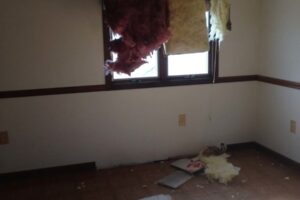 The questions I got about Efflorescence looked like these…
The questions I got about Efflorescence looked like these…
Is the white stuff growing on my basement wall efflorescence? How can I tell?
What is that white powder growing on my concrete walls?
There’s a white residue bubbling up from the floors and walls of my basement, could that be efflorescence?
…. Do you have similar questions? Then keep reading. (*This response is from my own experiences and research. Please consult a professional.)
What is Efflorescence?
Efflorescence is a white powdery film or dusty residue that shows up on masonry surfaces on the inside or outside of a house. It’s usually found on the concrete blocks in basements but can be found many other places.
Efflorescence can look similar to mold but when touched, the crystals crumble into a fine powder.
Although that white stuff looks like mold spores they’re not. The white powdery residue forms when there is excess moisture in the environment which causes water soluble alkaline salt to leach out of the masonry and form crystals.
It can cause paint to peel and can even lift floor tiles that were applied directly to the concrete floor! Sometimes if a wall or floor is painted, the growth of efflorescence will cause the paint to look as though it’s bubbling up and it will eventually crack out and cause the paint to crumble. (Kind of like the picture above.)
Left to it’s own devices, efflorescence usually doesn’t cause structural damage or harm by itself but it can be a little unsightly.
Is Efflorescence Harmful?
For Your Health
Efflorescence is really just salt deposits on your concrete (or brick or wherever you found it) so it’s not known to be harmful. However, most professionals (and me!) encourage you to wear proper eye, hand and mouth/nose protection when handling it.
It’s important to note for health reasons that if the source of excess moisture is not remedied, mold could begin to form where a food source is available for it to thrive!
For Your Foundation
Efflorescence on it’s own, is not harmful but could signify that the foundation has too much moisture in it (if it was found on basement walls.) Constant excess moisture in your foundation is not a good thing and could be caused by a variety of things. So not only to inhibit future mold growth but also to prevent deterioration of your foundation you need to get the root cause of the efflorescence taken care of.
Where is Efflorescence Found?
Efflorescence can be found anywhere there is concrete or brick but the most common places to find this white substance is in basements (hence the title of the page “basement wall efflorescence.”) It usually appears on the block walls but can also enter through mortar joints, flashing, cracks or absorption through porous areas in the masonry.
Brick walls and chimneys are also very susceptible to efflorescence.
Efflorescence is actually pretty common in new construction homes because of the excess amount of moisture in the freshly laid block or poured concrete but will most likely disappear over time.
How does this happen?
Alkaline salts are always present in masonry. When the moisture levels get high, the alkaline salts get pushed to the surface which causes the white stuff to form on the surface. It’s that simple.
How to Get Rid of Efflorescence
If you want to clean up the unsightly powder, it’s actually quite simple:
- First, grab some gloves and a dust mask!
- Second, because efflorescence is caused by excess moisture, it’s not advisable to start cleaning with water, it will only drive the alkaline salts deeper into the block. Use a dry wire brush to scrub off the powder (I use a shop vac to clean up the loose powder that falls).
- If the crystals already formed a hard crust, you can use a wooden or plastic scraper to easily remove the big stuff and then use the dry wire brush on the leftovers.
- If there’s still a little left on the wall, use a small amount of water and scrub with the wire brush. That’s it!
You don’t need to use chemicals or antibacterial cleaners because it’s just salt (unless some mold has also formed as well.)
How to Prevent Efflorescence
So now that you’ve gotten rid of the unsightly efflorescence, you don’t want it to come back right?
If you want to prevent efflorescence try reducing moisture levels in your masonry. This can be as simple as extending your downspouts to push the water farther away from the foundation or as complex as installing underground pipes to carry water away from the perimeter of the home.
A swale can be installed by a professional to carry the water away. In any case, always make sure the ground is sloping away from the house so that water can be naturally moved away from the foundation.
You should also examine all the flashing, mortar joints and sills for places water might be able to sneak in.
So there you have it. Everything you wanted to know and probably didn’t want to know about Efflorescence.
Send me more of your questions and I’ll be sure to answer them on the “Your Questions :: My Answers” series of blog posts.



 If you have any of the above questions or have typed any of the following into google… you’re in the right place:
If you have any of the above questions or have typed any of the following into google… you’re in the right place:


